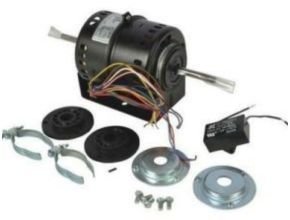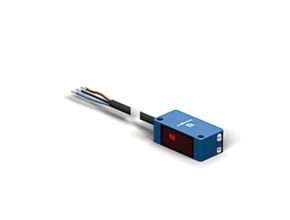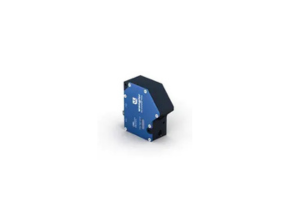Description
Dayton motors manufacture principally electric motors, and heating, ventilation, and air conditioning (HVAC) equipment. Dayton manufacturing standards meet stringent quality requirements on all products, making Dayton a recognized leader in producing reliable industrial, commercial, and residential products. Established in 1937, Dayton has grown to be one of the most dependable names in the motor industry.
The Products of Dayton Motors
Dayton Motors are electrical devices that convert electrical energy into mechanical energy. They operate through the interaction between the motor’s magnetic field and electric current in a wire winding to generate force in the form of torque applied on the motor’s shaft. Motors can be powered by direct current (DC) from a battery or by alternating current (AC) from an electrical power grid or electrical generator.
AC Motors
AC motors are electrical devices that convert electrical current into mechanical rotational energy, or torque, by using alternating current (AC) from an electrical power grid or electrical generator. General-purpose AC motors, also known as induction motors, are electric motors that use a rotating magnetic field to generate torque for powering conveyors and machine tools.
HVAC AC motors are used in equipment such as fans, blowers, air conditioners, heaters, and compressors. Pump AC motors move an impeller in a pump assembly and are used in pump systems to transfer water and other liquids.
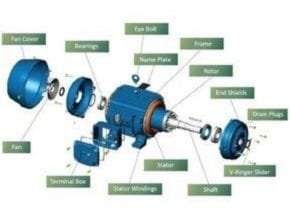
Definite-purpose AC motors have mechanical features designed for a specific purpose or application.
The Product classifications of AC Motors :
- Air compressor AC motors power air compressors that generate compressed air for use with air-powered equipment on job sites, auto repair shops, and in manufacturing facilities. They have an open drip-proof (ODP) enclosure with openings in the end shields and shell placed so drops of liquid falling within 15° from vertical will not affect motor performance.
- Definite Purpose Motors motors are AC motors with mechanical features designed for a specific purpose or application. They are powered by alternating currents and require low power to start. The 50 Hz motors are for use on 50 Hz equipment based on European standards. Brake motors hold the equipment at a standstill when power is cut to the motor. Instant reverse motors provide instant reversibility with a moderate starting force. Stationary power tool motors operate metalworking and woodworking equipment. Vector (inverter) AC motors provide continuous constant torque performance across an entire speed range. Vibrator motors promote material flow while brushless blowers have a high power-to-weight ratio for hand-held power tools.
- Farm-duty AC motors also known as agricultural fan motors, have a high starting torque that allows them to start under large loads. They provide reliable service in dirty and rough environments and are commonly used for crop drying, running poultry equipment, manure pumps, augers, and conveyors. Motors have enclosures that help protect them from moisture, but they are not airtight or waterproof.
- General-purpose AC motors also known as induction motors, are electric motors that convert AC power into torque (where torque is the measure of a rotational or twisting force) to drive mechanical loads. They are suitable for powering pumps, blowers, conveyors, and machine tools. Split-phase NEMA frame general purpose AC motors are lower efficiency and have a lower starting torque for a softer startup compared to other AC motors. Capacitor-start NEMA frame general-purpose AC motors use a capacitor to provide additional power during startup for higher torque. Capacitor-start/run NEMA frame general-purpose AC motors are single-phase motors that use a capacitor to provide additional power during startup for higher torque and a separate capacitor to run with higher operating efficiency. Three-phase NEMA frame general-purpose AC motors and three-phase IEC metric motors operate on efficient three-phase power with high torque and don’t require start or run capacitors.
- HVAC AC motors are used in equipment such as fans, blowers, pumps, air conditioners, heaters, and compressors. Direct drive blower and belt drive HVAC AC motors circulate air in roof ventilators and air circulators. Room air conditioner AC motors circulate cool air generated by room air conditioners while water circulator AC motors provide power to hot water circulation pumps. Unit heater AC motors power fans that circulate heat out of the heater and into the room. Draft booster AC motors are used to clear out any lingering combustion gases in gas furnace applications while transformer cooling fan AC motors power fans to cool electrical transformers.
- Pump AC motors move an impeller in a pump assembly to transfer water and other liquids. Car wash motors are for use in car washing facilities where frequent washdowns occur while carbonator pump motors are for use with vending machines and other hub-mounted pumps. Close-coupled pump motors are for use in centrifugal pump applications. Fire pump motors can power pumps in fire sprinkler systems while jet pump motors transfer water from groundwater sources. Oil well pump motors are used in oil drilling operations. Pool and spa pump motors circulate water in swimming pools while pressure washer motors are used to pump water at high pressure in cleaning operations.
- Vacuum AC motors rotate a motor fan to create vacuum pressure and suction in commercial canister vacuums, material handling, and central vacuuming systems. Motors should not come in contact with foam, liquids, or moisture-laden air.
- Washdown AC motors power conveyors in high humidity and wet environments where equipment needs to be regularly hosed down and cleaned during washdown procedures such as in chemical, pharmaceutical, food, and beverage production. They are totally enclosed to withstand water or other liquids that can damage the motors’ internal components. Motor shafts have V-ring rotating shaft seals and spring-loaded contact seals while the motor bearings are lubricated with moisture-resistant grease for further washdown protection.
DC Motors
DC motors produce a high starting torque and power to drive equipment such as conveyor belts, elevators, cranes, and hoists. General-purpose DC motors generate a constant torque throughout their speed range where a wide operating speed range with constant torque is required. Washdown DC motors can handle wet and high-humidity environments.
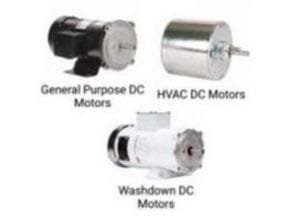
DC motor and control assemblies are for use on constant or diminishing torque applications such as a conveyor belt. Stepper motors can run for a specific interval, or step, allowing them to start, stop and reverse direction. Hazardous location DC motors are for use in locations where hazardous vapors or combustible dust are present.
The Product classifications of DC Motors :
- General-purpose DC motors produce a constant torque (where torque is the measure of a rotational or twisting force) throughout their speed range making them ideal for use when the load is not significantly altered by the speed and provide full-rated torque at low rpm in conveyor belts, hoists, mixers, and positive displacement pumps. They have ball bearings that can handle heavier radial and axial loads due to the high torque that DC motors can produce. Motors are designed for mechanical loads and for hard-to-start applications such as conveyors, belt-driven equipment, machine tools, mixers, positive displacement pumps, and reciprocating pumps.
- HVAC DC motors are for use where variable speed and high torque, where torque is the measure of a rotational or twisting force, are required in HVAC applications such as air moving or in refrigeration equipment.
- Washdown DC motors have a totally enclosed housing that can withstand wet/high-humidity environments or frequent washing for cleanliness and sanitation. The housing helps keep dirt and moisture from getting inside the motor while drain holes allow any condensation inside the housing to drain out. They are commonly used in beverage, chemicals, food, and pharmaceutical applications.
Motor Capacitors
Motor capacitors temporarily store an electrical charge to provide extra torque and improve a motor’s performance and efficiency. Start capacitors deliver extra torque during motor startup, then exit the circuit once the motor reaches operating speed. Run capacitors help the motor maintain a consistent charge while running.

Power factor correction capacitors reduce motor power consumption caused by heavy inductive loads by balancing working power and supplied power. Motor capacitors are primarily used for powering motors in HVAC applications such as fans, blowers, and compressors, but they are also used in a variety of equipment including pumps, conveyors, and machine tools.
The Product classifications of Motor Capacitors :
- Motor start capacitors temporarily store an electrical charge to deliver extra torque (where torque is the measure of a rotational or twisting force) during motor startup. They exit the circuit once the motor reaches its operating speed, unlike run capacitors, which help maintain a motor’s running performance. Motor capacitors are primarily distinguished by their capacitance value, which is measured in microfarads (mfd or µF). When replacing a start capacitor, it’s important to match the microfarad rating, voltage, and dimensions to the original capacitor. Start capacitors work with motor designs designated as capacitor-start or capacitor-start/run, and they are typically used with motors that power fans, blowers, and pumps.
- Motor-run capacitors maintain a charge and stay energized while a motor is operating. They improve a motor’s running performance by continuously providing additional torque, whereas start capacitors exit the circuit once the motor reaches its operating speed. When replacing a run capacitor, it’s important to match the shape (round, oval, or rectangle) and the microfarad rating, voltage, and dimensions of the original capacitor. Run capacitors are typically used with medium-to-high torque applications required for air conditioners, auger drives, compressors, and conveyors.
- Motor capacitor service kits include parts and accessories for repairing and maintaining capacitors. Kits support HVAC service technicians and contractors working in the field.
- Motor capacitor accessories are optional parts that help with the installation and maintenance of motor capacitors. They include mounting hardware, connector protectors, resistors, and jumper wires.
Motor Drives & Speed Controls
Motor drives and speed controls connect to the power supply and adjust the electrical current to regulate the speed. They give more control over the motor to meet the power needs of the application, which also improves motor performance and reduces energy consumption.
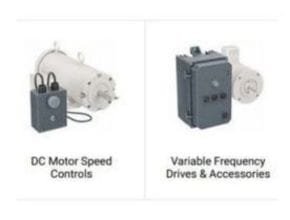
These speed controls, soft starts, and variable frequency drives (VFDs) are primarily used in motor applications that require constant or diminishing torque, such as conveyor belts, fans, pumps, blowers, and industrial automation.
The Product classifications of Motor Drives & Speed Controls :
- Dayton Motors DC Motor speed controls, govern adjustable acceleration and deceleration speeds, and they protect the motor from sudden electrical surges. Pulse width modulation (PWM) devices adjust voltage pulses to regulate speed. Silicon-controlled rectifier (SCR) controls convert AC voltage to DC voltage and provide variable speed control. These speed controls are used with permanent magnet or shunt wound DC motors, and with DC gear motors in constant or diminishing torque applications such as conveyors, packaging equipment, and centrifuges.
- Dayton Motors Variable frequency drives (VFDs) connect to a motor’s electrical supply and vary the frequency of the electricity powering the motor. This controls the motor’s performance and reduces the amount of energy the motor consumes. Drive reactors and filters protect VFDs and motors from harmful current disturbances. Accessories are optional components and kits that improve VFD performance.
Reference: www.grainger.com
Read More Articles :
- Wichita Clutch Air Brake
- Lenc Energy Gas Solenoid Valve
- Chester Machine Tools
- Helical Gear Reducer Hansen M4 ACC
- Hansen P4 Multistage Vertical Sumitomo Drive Technologies

